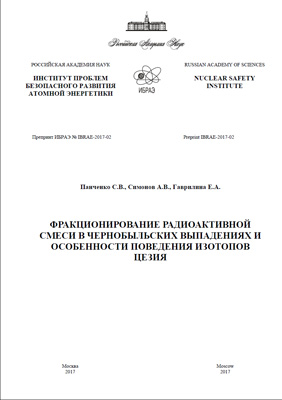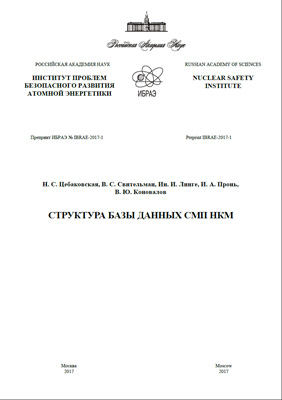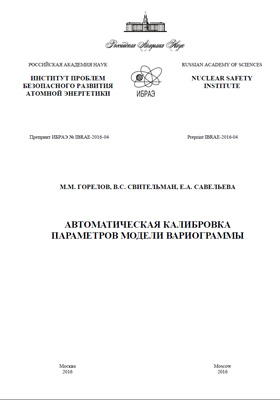| Ðóññêèé / English |
|

|
NUCLEAR SAFETY INSTITUTE OF THE
RUSSIAN ACADEMY OF SCIENCES
|
PREPRINTS
 | Calculation and forecasting system RELTRAN for safety analysis of the nuclear legacy facilities. Concept development (Preprint IBRAE-2017-06) Preprint IBRAE-2017-06 Bakin R.I., et al. The paper considers the concept of the basic calculation and forecasting system RELTRAN (CFS "R"). The system is developed in the course of the R&D "Establishment of practical methodology for comprehensive safety justification of the nuclear legacy facilities and radioactive waste disposal sites, including the development and implementation of system of codes and calculation and forecasting systems" within the framework of the FTP NRS-2. Bibliographical reference © Nuclear Safety Institute, 2017 |
 | The review of uncertainty analysis software (Preprint IBRAE-2017-05) Preprint IBRAE-2017-05 Svitelman V.S., Saveleva E.A. The paper includes the overview the existing uncertainty assessment software and the analysis of their applicability to the safety case and safety assessment for a radioactive waste disposal. The review shows that none of these software products covers full range of uncertainty analysis problems essential in long-term safety assessment. But many of them could be useful for selection, comparison and validation of the required computational techniques. Bibliographical reference V.S. Svitelman, E.A. Saveleva. The review of uncertainty analysis software / Preprint IBRAE-2017-05 — Moscow: Nuclear Safety Institute, 2017 — 18 p. — Bibliogr: 50 items. © Nuclear Safety Institute, 2017 |
 | International experience in deep geological disposal of SNF and RW. Part 1. Current progress in deep geological disposal of radioactive waste and spent fuel in the U.S., Canada and Asian countries (Preprint IBRAE-2017-04) Preprint IBRAE-2017-04 Cebakovskaya N.S., et al. This paper continues a series of publications summarizing current international experience in the establishment and operation of underground research laboratories and deep geological repositories for spent nuclear fuel and long-lived radioactive waste. Bibliographical reference N.S. Cebakovskaya, S.S. Utkin, V.Yu. Konovalov. International experience in deep geological disposal of SNF and RW. Part 1. Current progress in deep geological disposal of radioactive waste and spent fuel in the U.S., Canada and Asian countries / Preprint IBRAE-2017-04 — Moscow: Nuclear Safety Institute, 2017 — 41 p. — Bibliogr: 42 items. © Nuclear Safety Institute, 2017 |
 | International experience in deep geological disposal of SNF and RW. Part 1. Current progress in deep geological disposal of radioactive waste and spent fuel in European countries (Preprint IBRAE-2017-03) Preprint IBRAE-2017-03 Cebakovskaya N.S., et al. This paper is the first in a series summarizing current international experience in the establishment and operation of underground research laboratories and deep geological repositories for spent nuclear fuel and long-lived radioactive waste. Bibliographical reference N.S. Cebakovskaya, S.S. Utkin, I.I. Linge, I.A. Pron. International experience in deep geological disposal of SNF and RW. Part 1. Current progress in deep geological disposal of radioactive waste and spent fuel in European countries / Preprint IBRAE-2017-03 — Moscow: Nuclear Safety Institute, 2017 — 35 p. — Bibliogr: 47 items. © Nuclear Safety Institute, 2017 |
 | Fractionation of radioactive mixture in Chernobyl deposits and peculiarities of behavior of isotopes of cesium (Preprint IBRAE-2017-02) Preprint IBRAE-2017-02 Panchenko Sergey, et al. Empirical data on the fractionation of radioactive elements emitted into the atmosphere as a result of the Chernobyl accident are systematized in the paper. With regard to volatile elements such as the isotopes of iodine and cesium, the fractionation factor varied from 0.5–0.7 to several thousands. When radionuclides were deposited on different surfaces under various weather conditions, differences between superficial fractionation factor and the air one were also noticed. The behavior of cesium isotopes in deposition among all the elements considered was the most unusual. Bibliographical reference Sergey Panchenko, Aleksandr Simonov, Ekaterina Gavrilina. Fractionation of radioactive mixture in Chernobyl deposits and peculiarities of behavior of isotopes of cesium / Preprint IBRAE 2017-02. Moscow: Nuclear Safety Institute, 2017. — 14 p. © Nuclear Safety Institute, 2017 |
 | The structure of SMP NKM data base (Preprint IBRAE-2017-01) Preprint IBRAE-2017-01 Cebakovskaya N.S., et al. The paper introduces the structure of a database designed to store the outputs of the first R&D phase “Development of a Strategic Master Plan Supporting the Safety Case and Safety Assessments for a Deep Geological Disposal Facility for Class 1 and Class 2 RW in the Nizhnekansk massif (Eniseysk area)”. The paper overviews the international experience in the development of databases and information systems used to organize huge arrays of data supporting RW and SNF disposal projects gained during the past decades (USA, Belgium, Sweden, Finland, Switzerland and Japan). Perspectives for the enhancement of the purposed SMP NKM database were outlined based on this analysis enabling its transformation from a design history file into a comprehensive information system involving three main sub-systems: requirement management sub-system, knowledge management sub-system and R&D management sub-system. Bibliographical reference N.S. Cebakovskaya, V.S. Svitelman, In.I. Linge, I.A. Pron, V.Yu.Konovalov. The structure of SMP NKM data base / Preprint IBRAE-2017-1 — Moscow: NSI RAS, 2017 — 35 p. — Bibliogr: 31 items. © Nuclear Safety Institute, 2017 |
 | Automatic calibration of the variogram model parameters (Preprint IBRAE 2016-04) Preprint IBRAE-2016-04 Gorelov M.M., et al. The estimates obtained by numerical simulation are commonly used in the safety case and safety assessment. Numerical simulation is inevitably associated with the various types of uncertainties. And the variation of model parameters (that can be represented by two-dimensional or multi-dimensional fields) is required for uncertainty analysis. Thus the problem of random fields generation based on the spatial correlation model of the input data arises. The classic way to describe the spatial correlation is a variogram. In isotropic case the variogram has the same appearance and parameters for all directions. Anisotropic spatial correlation can be parameterized using the isotropic model and anisotropy ellipse. In this case automatic calibration with optimization strategies and clear stop criteria becomes more efficient than manual parameter fitting. Another issue is the selection and configuration of the automatic calibration method, the efficiency and comparative analysis of different algorithms. In this paper we consider Levenberg-Marquardt and Particle Swarm optimization methods. Bibliographical reference Gorelov M.M., Svitelman V.S., Savelyeva E.A. Automatic calibration of the variogram model parameters. Preprint IBRAE 2016-04. Moscow: Nuclear Safety Institute, 2016. — 17 p. © Nuclear Safety Institute, 2016 |
 | Infrastructure for the complex decommissioning of nuclear submarines, surface nuclear-powered ships, and nuclear maintenance vessels in the North-West Russia (Preprint IBRAE 2016-03) Preprint IBRAE-2016-03 Bilashenko V.P., et al. In order to accelerate decommissioning of the retired NS, SNS, NMS, and ecological rehabilitation of the temporary SNF and RW storage facilities, within the period 1998-2002 Minatom of Russia organized implementation of works aimed at modernization of the infrastructure for complex decommissioning in the North-West Russia. The existing infrastructure might be required in solving the problem of rehabilitation of Arctic seas from dumped and sank radiation-hazardous objects. In this paper, we present the systematic information on the infrastructure for complex decommissioning. The preparedness of the infrastructure significantly affects making decisions about options and time of the required activities. We also consider the prospective of further usage and development of the infrastructure to meet the branch demands. Bibliographical reference Bilashenko V.P., Shvedov P.A., Kulikov K.N., Nizamutdinov P.A., Varnavin A.P., Knivel N.Ya. Infrastructure for the complex decommissioning of nuclear submarines, surface nuclear-powered ships, and nuclear maintenance vessels in the North-West Russia. Preprint IBRAE 2016-03. Moscow: Nuclear Safety Institute, 2016. — 22 p. © Nuclear Safety Institute, 2016 |
 | Description of the emergency radionuclide propagation prediction system (PARRAD) for existing russian nuclear power plants. Technology and functioning (Preprint IBRAE-2016-02) Preprint IBRAE-2016-02 Arutyunyan R.V., et al. PARRAD system developed in collaboration with NSI RAS and Hydrometeorological Research Center of Russia. The system is based on the Lagrangian stochastic model of the NOSTRODAMUS software coupled with numerical weather prediction model WRF-ARW. Current version of PARRAD includes the data base for the 9 domains of Russian nuclear power plants. This paper describes the methodological and functional components of the PARRAD system, and results of its tests. Bibliographical reference Arutyunyan R.V., Pripachkin D.A., Semenov V.N., Sorokovikova O. S., Krasnoperov S.N., Rubinstein K.G. Description of the emergency radionuclide propagation prediction system (PARRAD) for existing russian nuclear power plants. Technology and functioning. Preprint IBRAE 2016-02. Moscow: Nuclear Safety Institute, 2016. — 42 p. © Nuclear Safety Institute, 2016 |
 | Information and analytical support of the federal target program «Nuclear and radiation safety in 2008 and until 2015». (Preprint IBRAE-2016-01) Preprint IBRAE-2016-01 Tikhonova A. A., et al. The paper summarizes the experience gained from the implementation of information and analytical support processes for the Federal Target Program «Nuclear and Radiation Safety in 2008 and until 2015», including the Program adjustment, drafting relevant reporting documents, as well as evaluating the efficiency of particular efforts and the Program as a whole. Another issue considered is the development of summary and inventory lists of nuclear and radiation hazardous facilities and a data base for information and analytical support of efforts implemented under the Program. This work ensured effective reduction of risks associated with spent fuel and radioactive waste management. Bibliographical reference Tikhonova A. A., Tolstykh S. D., Arefinkina S. E., et al. Information and analytical support of the federal target program «Nuclear and radiation safety in 2008 and until 2015». Support experience and upgrading. Preprint ¹ IBRAE-2016-01. Moscow: Nuclear Safety Institute of the Russian Academy of Sciences (IBRAE RAN), 2016. — 19 p. © Nuclear Safety Institute, 2016 |
 |
IBRAE RAN © 2013-2025 | Site map | Feedback |